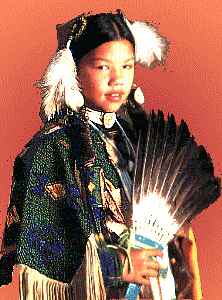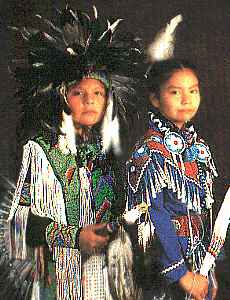FANCY POWWOW OUTFITS
| Page Buttons |
|---|
| Indian identity is fostered by dancing, and by very fancy outfits, which require major amounts of time (often by relatives) to make. Here powwow dancers express meanings dancing has for them, sometimes relating it to beadwork on their powwow outfits. | |
|---|---|
 |
Tasha June Cabanag, Turtle Mountain Ojibwe/Yakama, says:
"I started dancing before I could walk. Mom says she had me in moccassins and a wing dress while I was still in my baby board. I love to dance jingle, but I know I'll spend many years as a traditional dancer. My grandmother made my buckskin dress. |
"She spent many years gathering the beads for this dress. My grandmother has been unable to continue beading because her fingers have become raw from the needles; also the beads are no longer made in the colors of my dress. The hair wraps I wear are of otter skins; eagle feathers hang from beaded rosettes and porcupine medallions. I carry a shawl, a beaded purse, and one other item that means so much to me -- an eagle feather fan my uncle Rainbow made for me. " Front and wing sleeves of Tasha's dress are heavily beaded with a very unusual dark green bead (looks as if it might be faceted) and a very dark blue. Both are probably rebeadings using old pre-1940 beads. Her grandma did not use the lazy stitch -- the beads are sewn on double-needle in straight rows. As Tasha indicates, it as an enormous job for her grandma. | |
| Marty M. Pinnecoose (Eagle Child), Northern Ute/Jicarilla Apache says:
"The outfit I'm wearing is a fancy dance outfit consisting of two feather bustles. I chose the colors and the pattern of my outfit. These are sky colors from my Indian name. The pattern -- small diamond shapes -- stands for the mountains that surround my people. Fancy dancing started in the 1950's, when the young men didn't want to dance the slow traditional style. |
 |
"I have been fancy dancing since I was seven years old, and gradually made a name for myself." Marty wears a beaded headband, a V-shaped chest covering, a beaded white satin apron, arm bands, large cuffs, and two free-swinging blue diamond front panels. All carry out his theme of mountains made of sky. | |
| Jerome Tsinnajinnie, Dineh (Navajo) believes he was born dancing. At powwows he was taken to as a little child, he had no outfit. |  |
LaDonna Starr, Dineh (Jerome's younger sister) is wearing a Woodland style jingle dress. "People come up and ask questions about my outfit: who made this, who beaded that, where do you get all those cones? |
|---|---|---|
| "Before I started walking, I would just bounce to the drumbeat. At one powwow, I didn't have an outfit. My grandma and mom tried to get me out of the circle. The traditional dancers were getting ready to contest. I just stood there and watched them. Th Arena Director said 'Let him be. He is not in the way.' So, they left me to bounce with the elders. After the contst, people came up and shook my hand and gave me money. The gifts helped me to get my traditional outfit.` My family helped with my regalia. To this day, I am blessed with items from all my relatives." | "My grandparents tell me 'Powwow is a place where young people can enjoy themselves without getting into trouble.' They always know where to find us kids -- dancing in the circle." | |
 |
 Keli Smith, Tsimshian, is theoretically here because her outfit's whale clasp indicates that many tribes have found creative ways to use seed beads within their own traditions. Actually of course her pic was too cute to resist. Her grandma, Teresa Bariquit says: Keli Smith, Tsimshian, is theoretically here because her outfit's whale clasp indicates that many tribes have found creative ways to use seed beads within their own traditions. Actually of course her pic was too cute to resist. Her grandma, Teresa Bariquit says: | |
| "When I hear my grandaughter reply 'I am Tsimshian' to the question who she is, my heart glows with pride. At last I have lived to see my grandchildren grasp a part of my culture, and it is very dear to my heart. All of my life I have tried to gather all of the information about my tribe, so I can store it away in my memory. Now finally I am giving my cultural gift to my grandaughters." | ||
| After these wonderful thoughts (and outfits), I don't know if anyone wants to see The Zombi Carousel Powwow. Milwaukee Public Museum spent $1.5 million on this thing. A huge turntable with 37 dummies, dressed in the Museum's best, revolving around dummy drummers. I dunno why the museum would wanna do this, or why government and foundations would happily give the money, but it really baffles me that the Forest Co. Potawatomi Bingo gave them $250,000 for this atrocity. The museum has all sorts of nifty stuff, purchased for next to nothing in the 1940's from impoverished Wisconsin Indian people, but you won't see it on the web (they have a computer database of it, but not for us), and probably can't get too good a look at it on the zombi carousel either. How do they think up these things? Why is it so easy for them to get money for expensive idiocies like this, when Indian school funding is getting cut off to nothing??
Videoclips and powwow photos of powwows held at University of California Long Beach 1990-95. Put together by Indian Studies prof Troy Johnson, there's some explanations of the history of powwow (the word, the modern event), and videoclips (takes very long to download) of a grand entry and a grass dance, plus a gallery of photos. These non-dummies dance on the turntable of the circling earth! Some pretty nifty outfits, too. IHS Pow-Wow Page--Fairly complete Southwestern powwow listings (as yet almost no others), but also pix, memories, what to wear/see/do, how to act, food to serve at a ... Ryan seems to have lost interest, though, it hasn't been updated for almost a year. |
||
